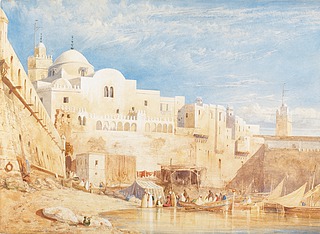
William Wyld, Harbor in Algiers, 1833, D656.
This article presents examples of how Thorvaldsen benefited from increased Danish sea traffic in the Mediterranean due to treaties signed by Denmark with a number of North African countries during the eighteenth century.
“The Barbary States” was a general term used to refer to the Ottoman states of Morocco, Algeria, Tunisia, and Tripolitania (present-day Libya) in North Africa. The Barbary States—or “the Barbary Coast,” “the Barbaries,” “the Berber Coast,” or “Barbary,” as the region was also called—was an area notorious for sea piracy and kidnappings of the European and American sailors who plied the waters of the Mediterranean and eastern Atlantic.
Following the repeated failure of attemptsI to stop piracy and enslavement by force, the major European sea powers all ultimately signed treaties providing tribute payments to the Barbary States in exchange for free passage for their trading shipsII.
Denmark, in particular, entered into a treaty with Algeria in 1746III guaranteeing free passage for Danish ships in exchange for an annual payment in the form of gifts, money, and arms (i.e., cannons, bombs, gunpowder, and bullets). Corresponding treaties were signed between Denmark and Tripolitania in January 1753IV, between Denmark and Tunisia in February 1753V, and between Denmark and Morocco in May 1753VI. As a result, each year a Danish so-called “gift ship” was sent with a “cargo of presents” to one of the Barbary States.

William Wyld, Harbor in Algiers, 1833, D656.
These agreements on the payment of tribute—or tolls, if you will—opened the Mediterranean to Danish trading companiesVII, shipwrights, and sailors, precipitating a great upswingVIII in trade, sea travel, and cultural exchange. One could now buy and sell one’s wares internationally, and Danish ships could take part in the growing traffic in goods between Mediterranean harbors and those in Northern and Western Europe.
Private trade and seafaring were supported by active official Danish policies, which were reflected in a large number of Danish consulates set up in harbor towns along the main routes of Danish trade. Denmark’s consuls helped to coordinate shipment traffic, and worked to ensure that communication between senders, receivers, shippers, customs officers, etc., proceeded smoothly. An example is the Danish consul in Leghorn, J. C. UlrichIX, who played a crucial role over the course of three decades in facilitating the shipment of Thorvaldsen’s artworks to customers throughout Europe.
Here are a number of other concrete examples of how Thorvaldsen profited, both during his travels and at his workshop, from Denmark’s connections with these North African states:
Last updated 08.08.2016
Cf. Wandel, op. cit., p. 1:
The contents of this paragraph and those that immediately follow are derived from Wandel, op. cit., as well as from Ole Feldbæk, Den lange fred (1700-1800), Handelsfremstød [The long peace (1700-1800): The trading campaign], Den Store Danske, Gyldendal.
Treaty of peace and commerce between Denmark and the Dey of Algiers, dated August 10, 1746; cf. Wandel, op. cit., pp. 10-11.
Treaty of peace and commerce between Denmark and the pasha of Tripolitania, Aly Caramelli, dated January 30, 1753; cf. Wandel, op. cit., p. 16.
Treaty of peace and commerce between Denmark and the Bey of Tunis, Ali Bascha Begler, early 1753; cf. Wandel, op. cit., p. 16.
Treaty of peace and commerce between Denmark and Muhamad ben Abdallah, Prince Regent of Morocco, dated July 1, 1752 (broken by Morocco), and renegotiated on May 18, 1753; cf. Wandel, op. cit., pp. 14-15, p. 17 (Thomsen, op. cit., p. 32, has the latter date as June 18, 1753).
For example:
See also Ole Feldbæk, Den florissante handelsperiode [The Period of Flourishing Trade], Den Store Danske, Gyldendal.
The Danish consul in Leghorn, J. C. Ulrich.
See the Archives’ Thorvaldsen chronology, under the date 30.8.1796.
See the Archives’ Thorvaldsen chronology, under the date 16.10.1796.
See the Archives’ Thorvaldsen chronology, under the date 15.11.1796
See the Archives’ Thorvaldsen chronology, under the date 18.12.1796.
See the Archives’ Thorvaldsen chronology, under the date 8.3.1797.
Cf. the letter dated 14.2.1806 from Herman Schubart to Thorvaldsen. The request was brought forward by the American priest for the protestant congregation in Leghorn, Thomas Hall.
Cf. Giovanni Charles Micali, Tripoli Monument, 1806, United States Naval Academy, Annapolis, Maryland, USA.
See the Related Article Transportation of Thorvaldsen’s Artworks to Copenhagen 1828.
Al-Husayn II ibn Mahmud, Bey of Tunis.
See the Archives’ Thorvaldsen chronology, under the date 1.5.1833.
See the Archives’ Thorvaldsen chronology, under the date 20.9.1833.
See the Related Article Transportation of Thorvaldsen’s Artworks to Copenhagen 1833.
The Danish naval officer, archaeologist, and numismatist Christian Falbe.
Cf. the letter dated 7.2.1843 from The Royal Collection of Coins and Medals to Thorvaldsen.
See the documents associated with the topic Thorvaldsen’s Collection of Coins.